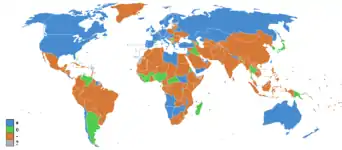International migration
International migration occurs when people cross state boundaries and stay in the host state for some minimum length of time.[1] Migration occurs for many reasons. Many people leave their home countries in order to look for economic opportunities in another country. Others migrate to be with family members who have migrated or because of political conditions in their countries. Education is another reason for international migration, as students pursue their studies abroad.[2] While there are several different potential systems for categorizing international migrants, one system organizes them into nine groups: temporary labor migrants; irregular, illegal, or undocumented migrants; highly skilled and business migrants; refugees; asylum seekers; forced migration; family members; return migrants; and long-term, low-skilled migrants.[3] These migrants can also be divided into two large groups, permanent and temporary. Permanent migrants intend to establish their permanent residence in a new country and possibly obtain that country’s citizenship. Temporary migrants intend only to stay for a limited periods of time; perhaps until the end of a particular program of study or for the duration of a their work contract or a certain work season.[4] Both types of migrants have a significant effect on the economies and societies of the chosen destination country and the country of origin.[5]

Similarly, the countries which receive these migrants are often grouped into four categories: traditional settlement countries, European countries which encouraged labour migration after World War II, European countries which receive a significant portion of their immigrant populations from their former colonies, and countries which formerly were points of emigration but have recently emerged as immigrant destinations.[6] These countries are grouped according to a dichotomy, either migrant-sending or migrant-receiving countries, which have distinct governance issues. But this dichotomy is artificial, and it obscures issues from view, for example, when a net migrant-sending country is also a 'receiver' of migrants.[7] All things considered, countries like the UAE have the most comprehensive multicultural population, accounting for almost 84% of the total population. Not only UAE, but countries like Qatar also has 74%, Kuwait has 60%, and Bahrain has 55% of their entire population are full of diverse people who emigrate from different countries such as (India, Bangladesh, and Pakistan) which increased population by 500% over the increase from 1.3 million in 1990 to 7.8 million in 2013.[8] Compared with the two governments in the United States, the Trump administration doubled the number of asylum and refugee seekers in the previous Obama administration by 12,000, and by 2020 it will only be 18,000. According to data from the immigration and border service, this year's has expected claims almost three times than the past, and it only got accepted less half than previous administrations. The number of reports returned to the Obama administration is 110,000, reaching 368,000 by 2020.[9] In these countries, economic development enabled by remittances, transnational activism in support of outgoing migrant rights, as well as rights for incoming migrants are issues.[10] As people began to immigrate to different countries to support them financially, they also contributed to their country’s economy by sending their income as remittances. According to a report by the World Bank, officials said that people from different countries remitted nearly US$400 billion in 2015, and this is increasing every year, with an increase of 0.4%, reaching US$586 billion in the following year.[11]
Statistics
It has been predicted, that on average at least "50% of the world population would live in a foreign country" if restrictions of immigration were to be liberalized. [12]
Incentives for migration
Push Factors
- Poor Medical Care
- Not enough jobs
- Few opportunities
- Primitive Conditions
- Political fear
- Fear of torture and mistreatment
- Religious discrimination
- Loss of wealth
- Natural disasters
- Bullying
- Lower chances of finding courtship
Pull Factors
- Chances of getting a job
- Better living standards
- Enjoyment
- Education
- Better Medical Care
- Security
- Family Links
- Lower crime
- Better chances of finding courtship
See also
References
- Where Immigrant Students Succeed - A comparative review of performance and engagement in PISA 2003. Paris: OECD Publications, 2006 (17-19).
- OECD International Migration Outlook, 2007, Paris: OECD Publications, 2007, SourceOECD 18 July 2007 http://www.oecd.org/about/0,3347,en_2649_33931_1_1_1_1_1,00.html.
- Where Immigrant Students Succeed (17-19).
- OECD International Migration Outlook, 2007.
- “Trends in International Migration and Migration Policies: About,” OECD Directorate for Labour, Employment and Social Affairs, OECD.org, 18 July 2007 http://www.oecd.org/about/0,3347,en_2649_33931_1_1_1_1_1,00.html .
- Where Immigrant Students Succeed (17-19).
- Palmer, Wayne; Missbach, Antje (2019-05-04). "Enforcing labour rights of irregular migrants in Indonesia". Third World Quarterly. 40 (5): 908–925. doi:10.1080/01436597.2018.1522586. ISSN 0143-6597.
- "Understanding the Gulf States". www.washingtoninstitute.org. Retrieved 2020-07-30.
- Shear, Michael D.; Kanno-Youngs, Zolan (2019-09-26). "Trump Slashes Refugee Cap to 18,000, Curtailing U.S. Role as Haven". The New York Times. ISSN 0362-4331. Retrieved 2020-07-30.
- Bal, Charanpal S.; Palmer, Wayne (March 2020). "Indonesia and circular labor migration: Governance, remittances and multi-directional flows". Asian and Pacific Migration Journal. 29 (1): 3–11. doi:10.1177/0117196820925729. ISSN 0117-1968. S2CID 220053545.
- "Remittances growth to slow sharply in 2015, as Europe and Russia stay weak; pick up expected next year". World Bank. Retrieved 2020-07-30.
- Delogu, M., Docquier, F., & Machado, J. (2018). Globalizing labor and the world economy: The role of human capital. Journal of Economic Growth, 23(2), 223-258. doi:http://dx.doi.org.libaccess.lib.mcmaster.ca/10.1007/s10887-017-9153-z
External links
- Stalker's Guide to International Migration Comprehensive interactive guide, with map and statistics
- OECD Trends in International Migration and in Migration Policies
- International Network on Migration and Development